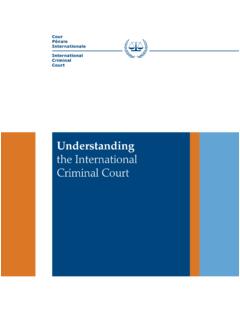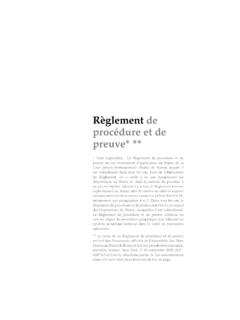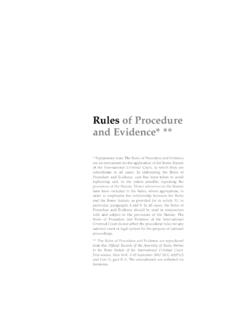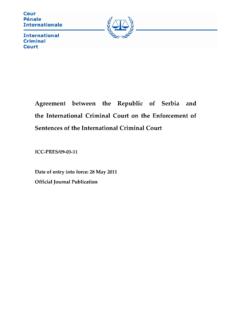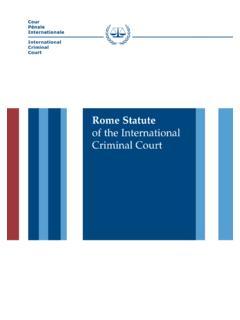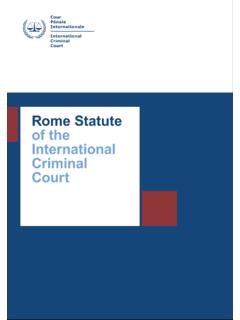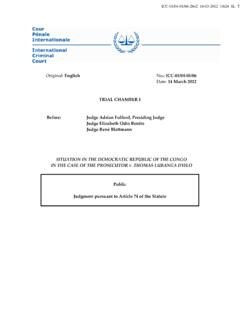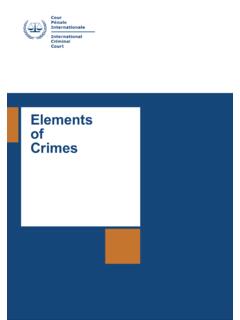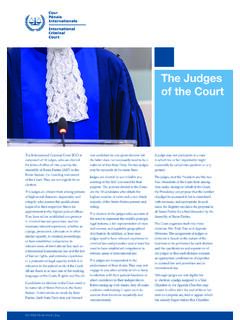Transcription of PROCUREMENT STANDARD OPERATING PROCEDURES (SOP)
1 PROCUREMENT STANDARD OPERATING PROCEDURES (SOP) 2 TABLE OF CONTENTS 1. RESPONSIBILITY Responsibility for Acquisition Responsibility for PROCUREMENT Planning 2. REQUISITION Requisitions for Supplies, Equipment and Services PROCUREMENT Requisitions 3. PURCHASING METHODS Competition Required Competition Level Sealed Bids 4. SOLICITATION DOCUMENTS Types of Solicitation Documents 5. SOLE OR SINGLE SOURCE 6. SUBMISSION AND RECEIPT OF BIDS Bid Opening Evaluation of Bids 7. PROCUREMENT REVIEW COMMITTEE 8. CONTRACT TYPES Purchase Orders Written PROCUREMENT Contracts Terms and Conditions PROCUREMENT Plan and Contract database 3 These PROCEDURES shall be implemented in a manner consistent with the responsibilities of the Prosecutor and of the Registrar as set out in article 42, paragraph 2, and article 43 paragraph 1, of the Statute.
2 1. RESPONSIBILITY Responsibility for Acquisition Pursuant to Rule (a) of the Financial Rules and Regulations of the Court, the Registrar is responsible for all PROCUREMENT functions of the Court. In accordance to Financial Rule (a), the over-all responsibility for the acquisition and the PROCUREMENT process of supplies, equipment and services are delegated to the Chief of the PROCUREMENT Section duly designated by the Registrar. To this end, the Chief PROCUREMENT Officer shall ensure that the relevant Financial Regulations and Rules on PROCUREMENT are strictly complied with. Responsibility for PROCUREMENT planning The PROCUREMENT planning is essential for the effective and timely solicitation of bids, proposals, award of contracts and delivery of the goods and services required for the operations of the Court.
3 Chiefs of Section are responsible for developing their PROCUREMENT plans in cooperation with the PROCUREMENT Section and the budget officers of the Court. 2. REQUISITION Requisitions for Supplies, Equipment and Services Supplies, equipment and services are ordered by requisitions which are raised by the Section Chiefs and/or requisitioning officers. All requisitions must be first certified by a duly designated Certifying Officer, as provided under Financial Rule Certifying Officers are officials designated by the Registrar for the account(s) pertaining to a section or sub-section of an approved budget, or by the Prosecutor in areas falling under his authority, in accordance with Financial Rule The main responsibilities of the Certifying Officers with regard to authorizing the requisitions are as follows: 4 (a) Review all requisitions in the light of actual needs for PROCUREMENT and to establish that funds are available for the goods/services being processed.
4 (b) Specifications should be comprehensive and unambiguous, and the description of scope of work in the requisition must be clear. A complete description or detailed specifications which may be available should be listed on the requisition for each item. It is of utmost importance for evaluating offers and for the winning supplier that Certifying Officers make sure that technical specifications of goods and/or services are sufficiently detailed. (c) Ensure that the requisitions are consolidated by line and type as much as possible PROCUREMENT Requisitions All requests for procuring supplies, equipment and services shall be submitted to the PROCUREMENT Section with a requisition using the Court s ERP System SAP. The requisitions shall include the following information: (a) A clear, concise statement of what is required.
5 This may consist of a simple description or a fully developed specification. To develop this specification, the Section Chiefs and/or the requisitioning officers may use experts within the Sections of the Court or, where appropriate, an outside source; (b) A detailed technical specification or Statement of Work, where applicable, prepared by the Section Chiefs and/or the requisitioning officers on a separate sheet and as an attachment to the requisition; (c) A contact person designated to answer questions concerning the requisition. In the case of contracts for large or complex goods or services, the contact person designated should be available throughout the PROCUREMENT process; (d) Delivery or completion date required; (e) The total estimated quantities and costs; (f) The budget code and WBS Element; (g) The recommended supplier(s) if available; (h) General comments or note on the requisitions necessary and relevant to the conduct of a conclusive and successful PROCUREMENT exercise.
6 5 The specifications should be generic in nature, in order to facilitate fair competition for the goods and services being acquired. Specifications shall not specify brand names, products of one company or features which are particular to the products of one company, unless it has been determined in writing by the requisitioner that these particular products or those particular features are essential to the Court s requirements, and that products of another company would not meet the requirements. Where proprietary items are specified or standardization is evoked, the requisitioner must provide justifications in writing to the Registrar or the Designated Officer for approval before the PROCUREMENT action is initiated. On occasion, brand name could be stated to clarify requirements, however adding or similar equipment or equivalent is compulsory.
7 It should be noted that PROCUREMENT Section will not process any requisition without proper certification of funding. Pursuant to Financial Rule , the approval in SAP of the Certifying Officer is proper certification of available budget funding. Certifying Officers are also responsible for maintaining detailed records of all obligations and expenditures against the accounts for which they have been delegated the responsibility. It is the responsibility of the Certifying Officers not to exceed the budget lines under his/her authority without prior authorization. 3. PURCHASING METHODS Competition The Court recognizes the basic principles of competition and equal treatment of bidders as outlined in Financial Rules and The principles of fair and equal competition ensure that the Court can obtain the best value for money by soliciting participation of a number of qualified bidders.
8 The principle of equality requires the Court to avoid preferring or discriminating against any bidder to the detriment or benefit of the other bidders. Required Competition Level If under 3, per purchase order, whether an item is to be bid will be at PROCUREMENT Section discretion and should be based upon many factors, including but not limited to the following: quantity, lead-time, and availability. If between 3, and 10, per purchase order, three (3) written competitive bids whenever possible should be obtained. 6If over 10, per purchase order, a minimum of three (3) competitive bids are required. Sealed Bids Sealed bidding is a method of soliciting competitive offers to purchase goods or services. The Court shall make an award to the supplier providing the best overall value to the Court, considering price and other related performance and quality factors.
9 The sealed bidding method of contracting is to be used when: (a) time permits solicitation, submission and evaluation of sealed bids; (b) the award is to be made on the basis of price and other factors related to performance and quality; (c) it is not necessary to conduct discussions with bidders because the goods or services being procured are quantitatively and qualitatively described in a manner which permits all bidders to bid on the same basis; and (d) there is a reasonable expectation of the Court receiving more than one sealed bid in the process. The bidding documents ( the solicitation ) are the means by which the Court informs potential bidders of the Courts requirements and conditions and by which interested bidders obtain the information needed to submit their bids.
10 The solicitation should reflect the nature and complexity of the goods or services being purchased and usually will include: (a) a Statement of Work (SOW) describing carefully and in full detail what the Court requires the supplier to perform or provide, including technical specification if applicable. The SOW must not be overly restrictive so as to eliminate qualified bidders; (b) the evaluation criteria upon which the Court will determine which bid meets the Court s requirements. In sealed bidding, evaluation focuses on price and other related factors such as: - Commercial Items: Base Bid Price Required Options Terms of Payment 7 Freight Terms Schedule of Terms and Conditions - Technical Terms.
